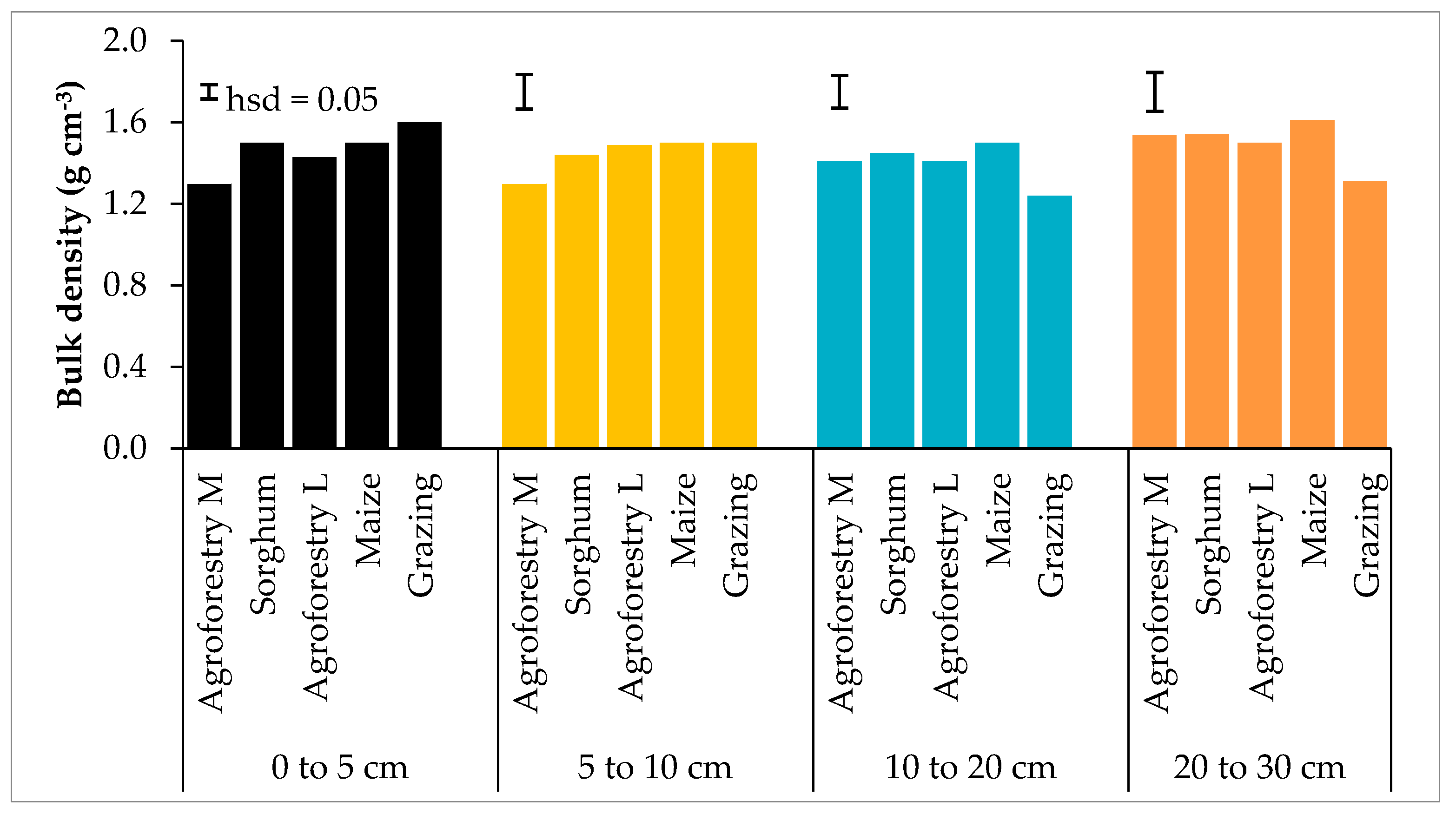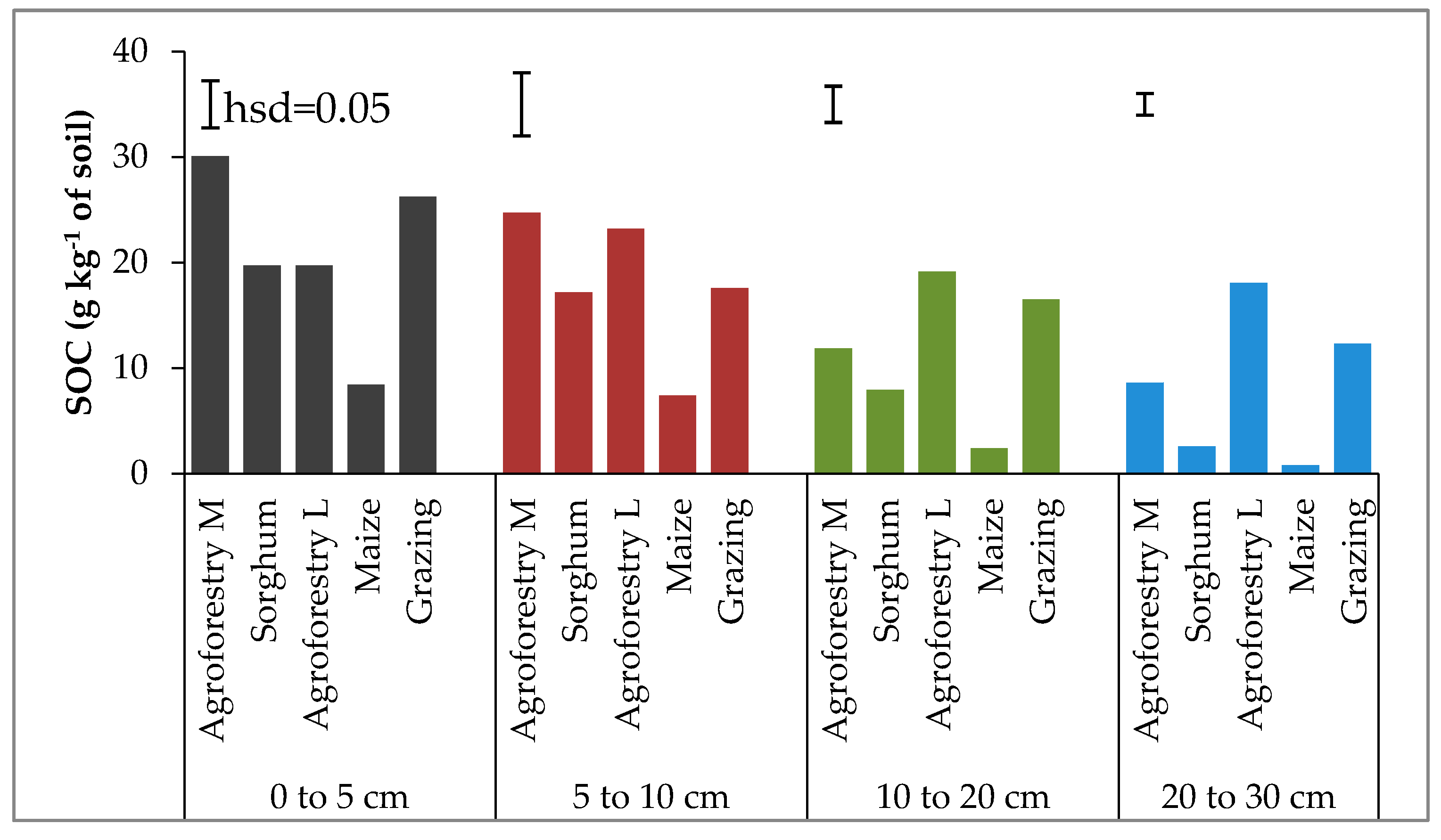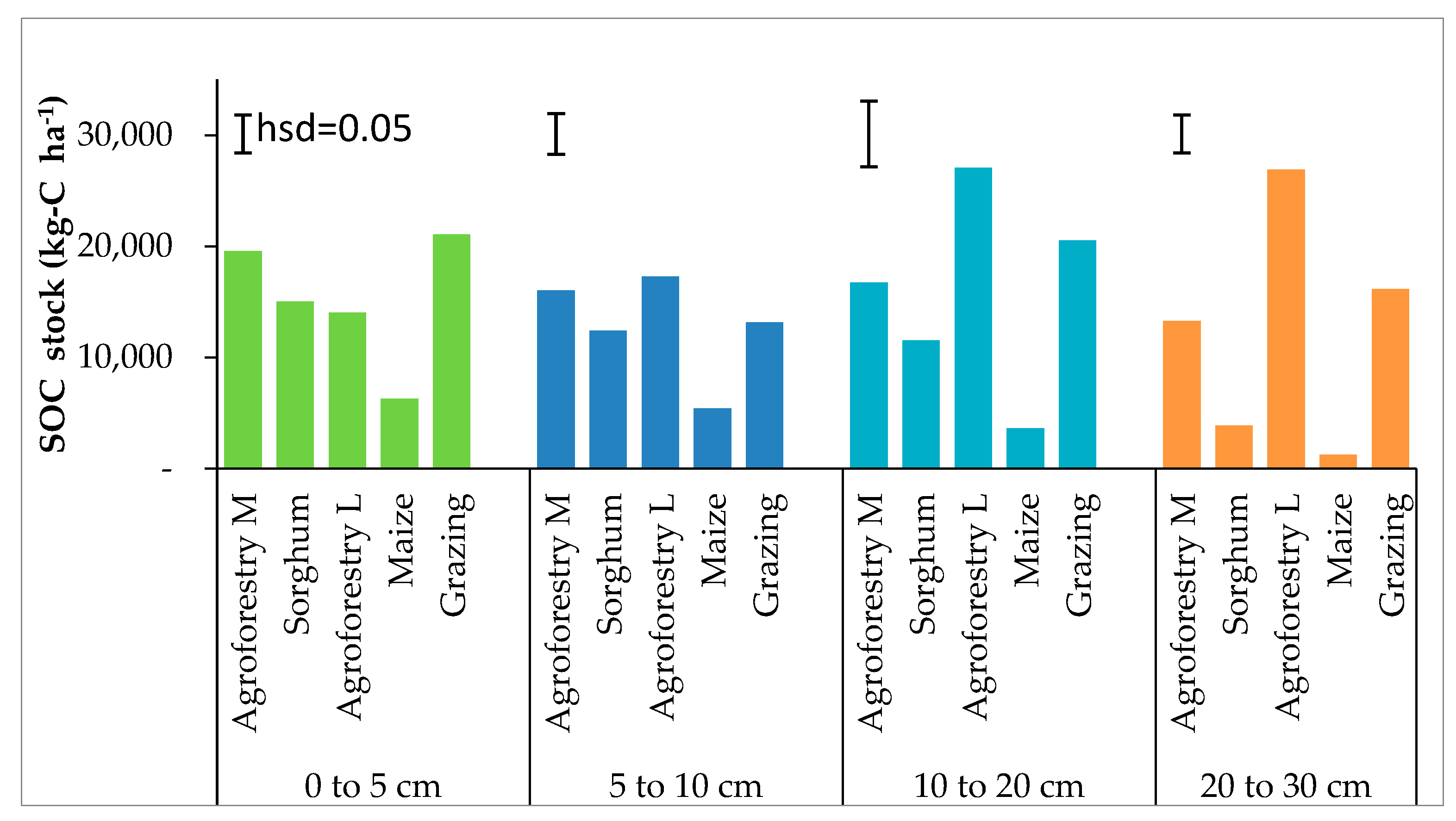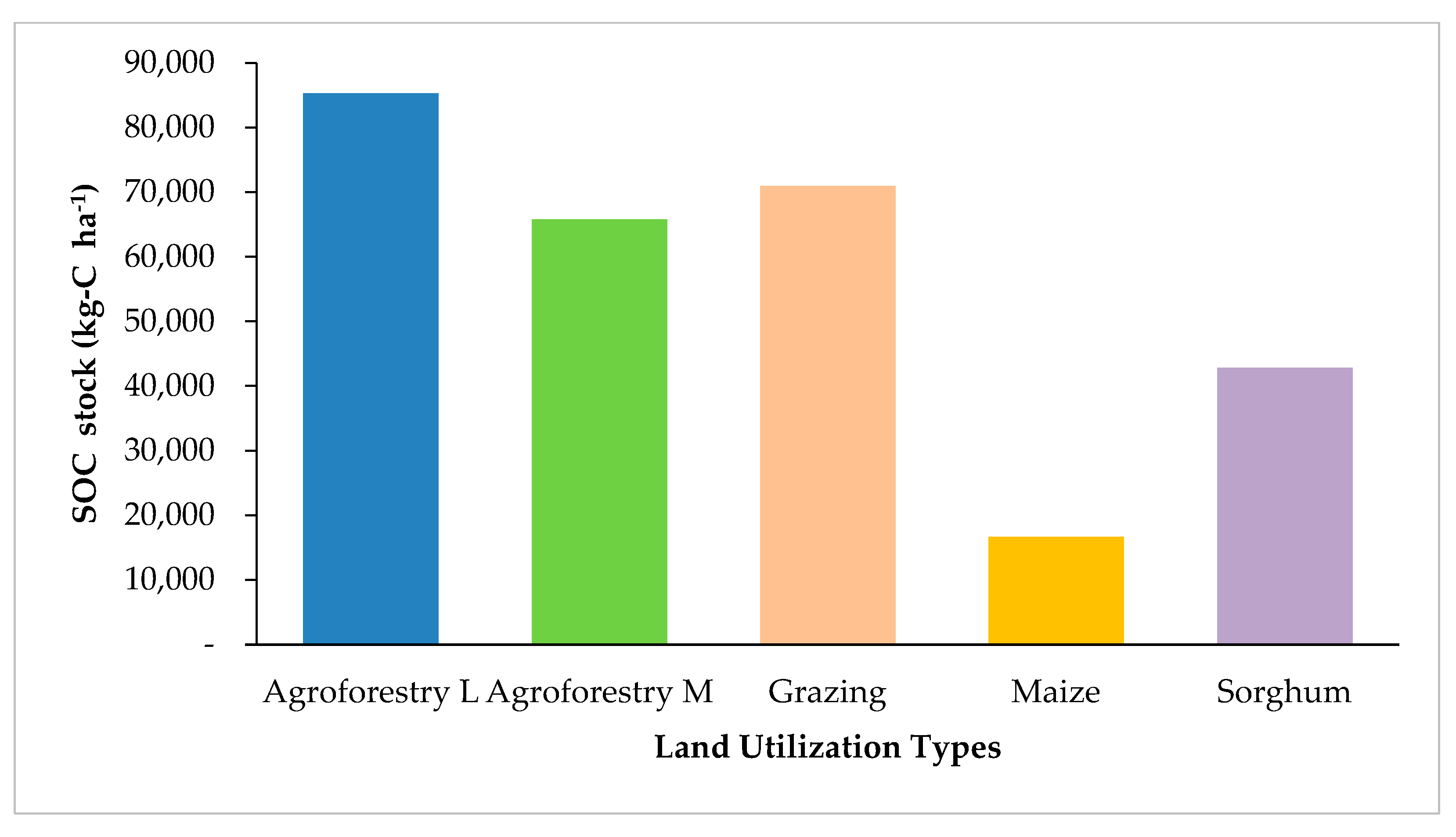Soil Organic Carbon Stocks under Different Land Utilization Types in Western Kenya
Abstract
:1. Introduction
2. Materials and Methods
2.1. Study Area
2.2. Experimental Design
2.3. Soil Sampling
2.4. Laboratory Analysis
2.5. Statistical Analysis
3. Results and Discussion
3.1. Soil Texture
3.2. Soil Bulk Density in Different Land Utilization Types at Different Depths
3.3. Soil Organic Carbon Contents in Different Land Utilization Types and Depths
3.4. Soil Organic Carbon Stock in Different Land Utilization Types and Depths
3.5. Percentage Distribution of SOC at Different Depths and Land Utilization Types
3.6. Correlation between Soil Bulk Density and SOC Concentration
4. Conclusions
Author Contributions
Funding
Institutional Review Board Statement
Informed Consent Statement
Data Availability Statement
Acknowledgments
Conflicts of Interest
References
- Guo, J.; Wang, B.; Wang, G.; Myo, S.T.; Cao, F. Effects of three cropland afforestation practices on the vertical distribution of soil organic carbon pools and nutrients in eastern China. Glob. Ecol. Conserv. 2020, 22, e00913. [Google Scholar] [CrossRef]
- Abegaz, A.; Tamene, L.; Abera, W.; Yaekob, T.; Hailu, H.; Nyawira, S.S.; Da Silva, M.; Sommer, R. Soil organic carbon dynamics along chrono-sequence land-use systems in the highlands of Ethiopia. Agric. Ecosyst. Environ. 2020, 300, 106997. [Google Scholar] [CrossRef]
- Gonçalves, D.R.; de Moraes Sá, J.C.; Mishra, U.; Cerri, C.E.; Ferreira, L.A.; Furlan, F.J. Soil type and texture impacts on soil organic carbon storage in a sub-tropical agro-ecosystem. Geoderma 2017, 286, 88–97. [Google Scholar] [CrossRef]
- Smith, P. Soil carbon sequestration and biochar as negative emission technologies. Glob. Chang. Biol. 2016, 22, 1315–1324. [Google Scholar] [CrossRef]
- Kanyenji, G.M.; Oluoch-Kosura, W.; Onyango, C.M.; Karanja Ng’ang’a, S. Prospects and constraints in smallholder farmers’ adoption of multiple soil carbon enhancing practices in Western Kenya. Heliyon 2020, 6, e03226. [Google Scholar] [CrossRef] [PubMed]
- Vanlauwe, B.; AbdelGadir, A.H.; Adewopo, J.; Adjei-Nsiah, S.; Ampadu-Boakye, T.; Asare, R.; Baijukya, F.; Baars, E.; Bekunda, M.; Coyne, D.; et al. Looking back and moving forward: 50 years of soil and soil fertility management research in sub-Saharan Africa. Int. J. Agric. Sustain. 2017, 15, 613–631. [Google Scholar] [CrossRef] [PubMed] [Green Version]
- Smith, P. Land use change and soil organic carbon dynamics. Nutr. Cycl. Agroecosyst. 2008, 81, 169–178. [Google Scholar] [CrossRef]
- Sommer, R.; Paul, B.K.; Mukalama, J.; Kihara, J. Reducing losses but failing to sequester carbon in soils–the case of Conservation Agriculture and Integrated Soil Fertility Management in the humid tropical agroecosystem of Western Kenya. Agric. Ecosyst. Environ. 2018, 254, 82–91. [Google Scholar] [CrossRef]
- Kim, D.G.; Kirschbaum, M.U.; Beedy, T.L. Carbon sequestration and net emissions of CH4 and N2O under agroforestry: Synthesizing available data and suggestions for future studies. Agric. Ecosyst. Environ. 2016, 226, 65–78. [Google Scholar] [CrossRef]
- Siaya County. County Integrated Development Plan (CIDP); Siaya County: Siaya, Kenya, 2018. [Google Scholar]
- Reppin, S.; Kuyah, S.; de Neergaard, A.; Oelofse, M.; Rosenstock, T.S. Contribution of agroforestry to climate change mitigation and livelihoods in Western Kenya. Agrofor. Syst. 2020, 94, 203–220. [Google Scholar] [CrossRef] [Green Version]
- Sheng, Z.; Du, J.; Sun, B.; Mao, J.; Zhang, Y.; Zhang, J.; Diao, Z. The Role of Plant Functional Diversity in Regulating Soil Organic Carbon Stocks under Different Grazing Intensities in Temperate Grassland, China. Sustainability 2022, 14, 4376. [Google Scholar] [CrossRef]
- Qiu, L.; Wei, X.; Zhang, X.; Cheng, J. Ecosystem carbon and nitrogen accumulation after grazing exclusion in semiarid grassland. PLoS ONE 2013, 8, e55433. [Google Scholar] [CrossRef]
- Silveira, M.L.; Xu, S.; Adewopo, J.; Franzluebbers, A.J.; Buonadio, G. Grazing land intensification effects on soil C dynamics in aggregate size fractions of a Spodosol. Geoderma 2014, 230, 185–193. [Google Scholar] [CrossRef]
- Kiboi, M.N.; Ngetich, F.K.; Muriuki, A.; Adamtey, N.; Mugendi, D. The response of soil physicochemical properties to tillage and soil fertility resources in Central Highlands of Kenya. Ital. J. Agron. 2020, 15, 71–87. [Google Scholar] [CrossRef]
- Corbeels, M.; Cardinael, R.; Naudin, K.; Guibert, H.; Torquebiau, E. The 4 per 1000 goal and soil carbon storage under agroforestry and conservation agriculture systems in sub-Saharan Africa. Soil Tillage Res. 2019, 188, 16–26. [Google Scholar] [CrossRef] [Green Version]
- Namirembe, S.; Piikki, K.; Sommer, R.; Söderström, M.; Tessema, B.; Nyawira, S.S. Soil organic carbon in agricultural systems of six countries in East Africa–a literature review of status and carbon sequestration potential. South Afr. J. Plant Soil. 2020, 37, 35–49. [Google Scholar] [CrossRef]
- Martín, J.R.; Álvaro-Fuentes, J.; Gonzalo, J.; Gil, C.; Ramos-Miras, J.J.; Corbí, J.G.; Boluda, R. Assessment of the soil organic carbon stock in Spain. Geoderma 2016, 264, 117–125. [Google Scholar] [CrossRef] [Green Version]
- Nyawira, S.S.; Hartman, M.D.; Nguyen, T.H.; Margenot, A.J.; Kihara, J.; Paul, B.K.; Williams, S.; Bolo, P.; Sommer, R. Simulating soil organic carbon in maize-based systems under improved agronomic management in Western Kenya. Soil Tillage Res. 2021, 211, 105000. [Google Scholar] [CrossRef]
- Ndung’u, M.; Ngatia, L.W.; Onwonga, R.N.; Mucheru-Muna, M.W.; Fu, R.; Moriasi, D.N.; Ngetich, K.F. The influence of organic and inorganic nutrient inputs on soil organic carbon functional groups content and maize yields. Heliyon 2021, 7, e07881. [Google Scholar] [CrossRef]
- Saidy, A.R.; Smernik, R.J.; Baldock, J.A.; Kaiser, K.; Sanderman, J. The sorption of organic carbon onto differing clay minerals in the presence and absence of hydrous iron oxide. Geoderma 2013, 209, 15–21. [Google Scholar] [CrossRef]
- Rahman, N.; Giller, K.E.; de Neergaard, A.; Magid, J.; van de Ven, G.; Bruun, T.B. The effects of management practices on soil organic carbon stocks of oil palm plantations in Sumatra. J. Environ. Manag. 2021, 278, 111446. [Google Scholar] [CrossRef]
- Jaetzold, R.; Schmidt, H.; Hornet, Z.B.; Shisanya, C.A. Farm Management Hand-Book of Kenya. In Natural Conditions and Farm Information, 2nd ed.; Ministry of Agriculture/GTZ: Nairobi, Kenya, 2010; Volume 11. [Google Scholar]
- De Groote, H.; Vanlauwe, B.; Rutto, E.; Odhiambo, G.D.; Kanampiu, F.; Khan, Z.R. Economic analysis of different options in integrated pest and soil fertility management in maize systems of Western Kenya. Agric. Econ. 2010, 41, 471–482. [Google Scholar] [CrossRef]
- Okalebo, J.R.; Gathua, K.W.; Woomer, P.L. Laboratory methods of soil and plant analysis: A working manual second edition. Sacred Afr. Nairobi 2002, 21, 25–26. [Google Scholar]
- Degu, M.; Melese, A.; Tena, W. Effects of soil conservation practice and crop rotation on selected soil physicochemical properties: The Case of Dembecha District, Northwestern Ethiopia. Appl. Environ. Soil Sci. 2019, 14. [Google Scholar] [CrossRef]
- Bruun, T.B.; Elberling, B.; de Neergaard, A.; Magid, J. Organic carbon dynamics in different soil types after conversion of forest to agriculture. Land Degrad. Dev. 2015, 26, 272–283. [Google Scholar] [CrossRef]
- Samuel, A.D.; Tit, D.M.; Melinte, C.E.; Iovan, C.; Purza, L.A.V.I.N.I.A.; Gitea, M.A.N.U.E.L.; Bungau, S. Enzymological and physicochemical evaluation of the effects of soil management practices. Rev. Chim. 2017, 68, 2243–2247. [Google Scholar] [CrossRef]
- Tanveera, A.; Kanth, T.A.; Tali, P.A.; Naikoo, M. Relation of soil bulk density with texture, total organic matter content and porosity in the soils of Kandi Area of Kashmir valley. India. Int. Res. J. Earth Sci. 2016, 4, 1–6. [Google Scholar]
- Hengl, T.; Mendes de Jesus, J.; Heuvelink, G.B.; Ruiperez Gonzalez, M.; Kilibarda, M.; Blagotić, A.; Shangguan, W.; Wright, M.N.; Geng, X.; Bauer-Marschallinger, B.; et al. SoilGrids250m: Global gridded soil information based on machine learning. PLoS ONE 2017, 12, e0169748. [Google Scholar]
- Gao, Y.; Zhou, J.; Wang, L.; Guo, J.; Feng, J.; Wu, H.; Lin, G. Distribution patterns and controlling factors for the soil organic carbon in four mangrove forests of China. Glob. Ecol. Conserv. 2019, 17, e00575. [Google Scholar] [CrossRef]
- Mishra, G.; Sarkar, A. Studying the relationship between total organic carbon and soil carbon pools under different land management systems of Garo hills, Meghalaya. J. Environ. Manag. 2020, 257, 110002. [Google Scholar] [CrossRef]
- Kadiri, W.O.; Fasina, A.S.; Babalola, T.S. Soil organic carbon concentration and stock of arable land use of two agroecological zones of Nigeria. J. Saudi Soc. Agric. Sci. 2021, 20, 180–189. [Google Scholar]
- Muhati, G.L.; Olago, D.; Olaka, L. Quantification of carbon stocks in Mount Marsabit Forest Reserve, a sub-humid montane forest in northern Kenya under anthropogenic disturbance. Glob. Ecol. Conserv. 2018, 14, e00383. [Google Scholar] [CrossRef]
- Henry, M.; Tittonell, P.; Manlay, R.J.; Bernoux, M.; Albrecht, A.; Vanlauwe, B. Biodiversity, carbon stocks and sequestration potential in aboveground biomass in smallholder farming systems of western Kenya. Agric. Ecosyst. Environ. 2009, 129, 238–252. [Google Scholar] [CrossRef]
- Sarto, M.V.; Borges, W.L.; Sarto, J.R.; Rice, C.W.; Rosolem, C.A. Deep soil carbon stock, origin, and root interaction in a tropical integrated crop–livestock system. Agrofor. Syst. 2020, 94, 1865–1877. [Google Scholar] [CrossRef]
- Kihara, J.; Bolo, P.; Kinyua, M.; Nyawira, S.S.; Sommer, R. Soil health and ecosystem services: Lessons from sub-Sahara Africa (SSA). Geoderma 2020, 370, 114342. [Google Scholar] [CrossRef]
- Bungau, S.; Behl, T.; Aleya, L.; Bourgeade, P.; Aloui-Sossé, B.; Purza, A.L.; Abid, A.; Samuel, A.D. Expatiating the impact of anthropogenic aspects and climatic factors on long-term soil monitoring and management. Environ. Sci. Pollut. Res. 2021, 28, 30528–30550. [Google Scholar] [CrossRef]
- Sarvade, S.; Singh, R.; Prasad, H.; Prasad, D. Agroforestry practices for improving soil nutrient status. Popular Kheti. 2014, 2, 60–64. [Google Scholar]
- Zhang, K.; Maltais-Landry, G.; Liao, H.L. How soil biota regulate C cycling and soil C pools in diversified crop rotations. Soil Biol. Biochem. 2021, 156, 108219. [Google Scholar] [CrossRef]
- Alavaisha, E.; Manzoni, S.; Lindborg, R. Different agricultural practices affect soil carbon, nitrogen and phosphorous in Kilombero-Tanzania. J. Environ. Manag. 2019, 234, 159–166. [Google Scholar] [CrossRef]
- Blanco-Canqui, H.; Stone, L.R.; Schlegel, A.J.; Lyon, D.J.; Vigil, M.F.; Mikha, M.M.; Stahlman, P.W.; Rice, C.W. No-till induced increase in organic carbon reduces maximum bulk density of soils. Soil Sci. Soc. Am. J. 2009, 73, 1871–1879. [Google Scholar] [CrossRef]
- Hobley, E.U.; Baldock, J.; Wilson, B. Environmental and human influences on organic carbon fractions down the soil profile. Agric. Ecosyst. Environ. 2016, 223, 152–166. [Google Scholar] [CrossRef] [Green Version]
- Zhang, X.; Liu, M.; Zhao, X.; Li, Y.; Zhao, W.; Li, A.; Huang, J. Topography and grazing effects on storage of soil organic carbon and nitrogen in the northern China grasslands. Ecol. Indic. 2018, 93, 45–53. [Google Scholar] [CrossRef]





| LUT 1 | Sand (%) | Clay (%) | Silt (%) |
|---|---|---|---|
| Agroforestry M | 47 | 18 | 34 |
| Sole sorghum | 48 | 15 | 37 |
| Agroforestry L | 46 | 18 | 36 |
| Sole Maize | 52 | 18 | 30 |
| Grazing land | 50 | 18 | 32 |
| LUTs | Coefficient | p-Value |
|---|---|---|
| Agroforestry M | −0.868 ** | 0.0003 |
| Sole sorghum | −0.138 | 0.7 |
| Agroforestry L | −0.140 | 0.7 |
| Sole Maize | −0.274 | 0.4 |
| Grazing land | 0.900 ** | 0.0001 |
Publisher’s Note: MDPI stays neutral with regard to jurisdictional claims in published maps and institutional affiliations. |
© 2022 by the authors. Licensee MDPI, Basel, Switzerland. This article is an open access article distributed under the terms and conditions of the Creative Commons Attribution (CC BY) license (https://creativecommons.org/licenses/by/4.0/).
Share and Cite
Kibet, E.; Musafiri, C.M.; Kiboi, M.N.; Macharia, J.; Ng’etich, O.K.; Kosgei, D.K.; Mulianga, B.; Okoti, M.; Zeila, A.; Ngetich, F.K. Soil Organic Carbon Stocks under Different Land Utilization Types in Western Kenya. Sustainability 2022, 14, 8267. https://doi.org/10.3390/su14148267
Kibet E, Musafiri CM, Kiboi MN, Macharia J, Ng’etich OK, Kosgei DK, Mulianga B, Okoti M, Zeila A, Ngetich FK. Soil Organic Carbon Stocks under Different Land Utilization Types in Western Kenya. Sustainability. 2022; 14(14):8267. https://doi.org/10.3390/su14148267
Chicago/Turabian StyleKibet, Esphorn, Collins Muimi Musafiri, Milka Ngonyo Kiboi, Joseph Macharia, Onesmus K Ng’etich, David K Kosgei, Betty Mulianga, Michael Okoti, Abdirahman Zeila, and Felix Kipchirchir Ngetich. 2022. "Soil Organic Carbon Stocks under Different Land Utilization Types in Western Kenya" Sustainability 14, no. 14: 8267. https://doi.org/10.3390/su14148267
APA StyleKibet, E., Musafiri, C. M., Kiboi, M. N., Macharia, J., Ng’etich, O. K., Kosgei, D. K., Mulianga, B., Okoti, M., Zeila, A., & Ngetich, F. K. (2022). Soil Organic Carbon Stocks under Different Land Utilization Types in Western Kenya. Sustainability, 14(14), 8267. https://doi.org/10.3390/su14148267







